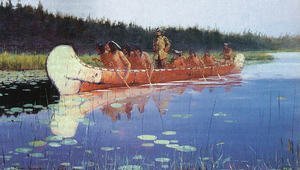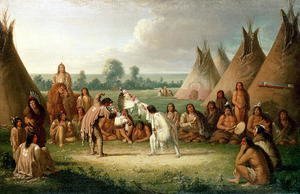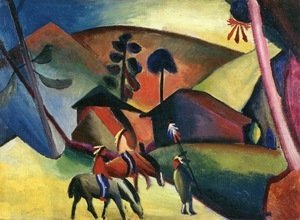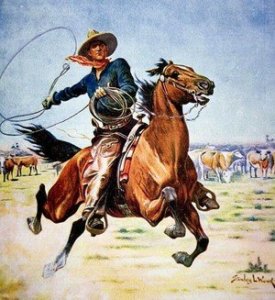Art history is brilliantly painted with a number of different movements. From the dramatic flair of the Baroque Era to the religious resurgence of the Renaissance, there is an almost unlimited number of topics that artists over the centuries have taken on.
In America, one of the biggest art movements has been the American Western Art Movement. From the adventure imbued in a wild west painting to the natural beauty in a landscape, this is a movement with a lot to offer viewers.
 The American Western Art Movement actually goes by many different names. As someone
The American Western Art Movement actually goes by many different names. As someone
learns about it, they might hear it referred to as Cowboy Art, Western Art, Old West Art, or
American Frontier Art. This is because there isn’t a single title for it as for eras like the
Impressionist Movement.
Generally, the accepted starting point for this period was all the way back in 1840. Interestingly, the period doesn’t have a specific stop date and the subjects in the paintings are popular among artists even to this day.

Many artists that art historians and the general populace deem masters today didn’t receive the fame in their life that one would expect. Similarly, the idea of Western American Art wasn’t always as generally accepted as it is today. Now, however, the art form is considered a major movement.
 Unlike movements such as Post-Impressionism or Baroque art, the American Western Art
Unlike movements such as Post-Impressionism or Baroque art, the American Western Art
Movement wasn’t bound to technique. When a viewer looks at a gallery of this art, they’re likely to see several different styles. That’s because the American Western Art Movement is tied together by substance, not style.
Subject matter such as ranchers and cowboys and even Western landscapes fall into the
category of American Western Art but where one might focus on colors and another on hyper-realistic brushstrokes, both would fall into consideration under this category.
It wasn’t just the movement of artists from east to west that filled this genre either. The
movement is also often used to encompass the artistry that Native Americans created as well.
 Taking American Western Art back to its origins it had a suggested purpose aside from just
Taking American Western Art back to its origins it had a suggested purpose aside from just
capturing the beauty of the Western landscapes and details of life on it. That is, at the very
least, the art created was used for a different purpose than aesthetic appeal during the time of the American frontiersman.
At the time, there wasn’t the advertising that society has today. High-powered cameras weren’t around to take beautiful and bright images for travel brochures. There definitely wasn’t a way to create commercials like the one modern consumers hear on their favorite apps or see on TV.
As such, these paintings were taken and used as an incentive. At the time, the United States was expanding its borders and wanted to settle its Western frontier. To do this, they needed plenty of people who were interested in settling in the West. So, these paintings were used to intrigue people and hopefully encourage them to move to the Western
Front.
For instance, an image of a cowboy swinging a lasso over his head could imbue a sense of
adventure in the viewer. Alternatively, a beautiful landscape could encourage the thought of an idyllic life in the West.
 Yet, it isn’t called propaganda without reason. Life in the West wasn’t easy but, of course, some artists chose to capture this. Settling a new front is difficult and it can take hard work and even sacrifice of life to pursue concepts such as the American idea of Manifest Destiny.
Yet, it isn’t called propaganda without reason. Life in the West wasn’t easy but, of course, some artists chose to capture this. Settling a new front is difficult and it can take hard work and even sacrifice of life to pursue concepts such as the American idea of Manifest Destiny.
The art that often found its way into propaganda use was largely focused on what the Western Frontier could offer rather than the sacrifices it required. After all, propaganda, at its core, is a method of advertisement. Showing people how much harder their life would become in the west wouldn’t draw people out.
So, for the purpose of propaganda, much of the art that graced magazines at the time were
idyllic representations of the west. Today, this has led to the expression of the “imagined West.” This is the western landscape that many chalk up to children’s games today. A world of cowboys going on adventures and heroic duels in front of town saloons.
Now, since the time of settlement is well-passed, the paintings of artists showing a more
historically accurate depiction of the West have risen to their rightful fame.
The American Western Art Movement has spanned generations, styles, and purposes. From the imagined West in propaganda art to the hardships shown in more historically accurate paintings, it is a genre that continues to give and one that has risen from a less-than-respectable position to the fame it deserves.
Comments
No comments on this item Please log in to comment by clicking here